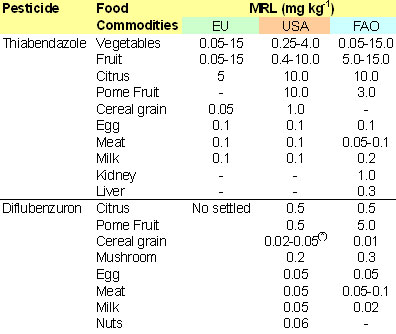Pesticide determination by LC
Yolanda Pico, University of Valencia, University of Valencia, SpainLevelBasic
The determination of pesticides is challenging for several reasons:
- The concentration of the analytes can be extremely low in the samples. As a result, the analytical methods must provide extremely high sensitivities in order to detect and quantitate such low analyte concentrations.
- The great variety of pesticides, which covers a wide range of polarities, from the highly apolar to many that are completely water soluble. The latter are considered the most dangerous since they are amenable to transport within the aquatic environment via leaching or runoff processes.
As a result, pesticide analyses demand state-of-art sampling, sample preparation, separation, detection and quantification techniques.
What is a pesticide?
A pesticide is any chemical which is used by man to control pests. The pests can be insects, plant diseases, fungi, weeds, nematodes, snails, slugs, etc. Currently, more than 800 pesticides (active ingredients) are sold worldwide in thousand of different formulations. Pesticides are grouped or classified according to the pests they control, their chemical structure, how/when they work, or their mode of action (site of action). The most useful way to classify pesticides in order to explain their analysis is by their chemical structure. The classic major chemical groups of pesticides are:
i) Organochlorines, which are a group of hydrocarbons with one or more chlorine atoms. Chlordane, dieldrin, and DDT are examples. Most of the members of this group have been outlawed in developed countries and are considered persistent organochlorine pollutants (POPs).
(ii) Organophosphates, including esters of phosphoric, phosphonic, phorothionic, or related acids. Some of the more common examples in this group are: diazinon, dichlorvos, and malathion.
(iii) Carbamates, formed by salts or esters of carbamic acid. Carbaryl and propoxur are examples.
(iv) Pyrethrins, are the most represented pesticides of plant origin. Synthetic pyrethroids, such as D-phenotrin, are similar in action to pyrethrum.
(v) Triazines consist of a number of substituted 1,3,5-triazines, which are classical herbicides.
(vi) Substituted ureas comprise a large number of groups such as phenylureas, sulfonylureas, or benzoylureas, which are mainly herbicides. Some urea derivatives have insecticide activity as well.
(vii) Triazoles are mainly fungicides, such as cyproconazole and myclobutanil.
Representative structures from each chemical group of pesticides will pop-up by clicking on the names of the group. All structures will pop up by clicking here.
General sources on pesticides
There are many sources for learning more about specific pesticides or the different classes of pesticides. Listed below are governmental, academic and non-governmental website links that contain additional information.
- The classes of pesticides:
http://www.agf.gov.bc.ca/pesticides/a_3.htm
http://en.wikipedia.org/wiki/Pesticide -
Lists of acaricides, fungicides, herbicides, insecticides, nematicides and plant growth regulators, as well as alphabetical lists of other categories of pesticides
http://www.alanwood.net/pesticides/class_pesticides.html - Individual pesticides are very well described and schematized in
http://www.inchem.org/pages/pds.html - The Pesticide Action Network (PAN) also has a searchable database with information on individual pesticides.
http://www.pesticideinfo.org/Index.html - http://extoxnet.orst.edu/pips/aldicarb.htm, provides information on pesticides and their health effects in a searchable database.
What are the problems with pesticides?
Pesticides are intended to deliberately kill living organisms. This can adversely impact the environment, wildlife and human health. Organisms may be affected directly or indirectly as a result of pesticide use:
- Pesticides indirectly affect non-targeted organisms and the environment by breaking food chains and disrupting the natural balance of an ecosystem. For example, the use of herbicides will reduce the amount of weeds and their seeds available to bird chicks, which will often starve as a consequence. Herbicides may also reduce the availability of appropriate habitats for predators, which can result in a decline of predators and a pest outbreak.
- Predators and non-target organisms can also be affected by direct contact with pesticides. Among humans, direct effects include poisonings, infertility, cancer, and even neurological disorders for those using organophosphates.
Many experts believe that the indirect effects on the environment may actually be more significant than the pesticides’ direct effects. Furthermore, some of the direct effects on human health have become of less concern as a result of tighter legislation in developed countries.
Pesticide impacts include:
- Water pollution - through leaching, run-off or spray drift; and
- Loss of farmland biodiversity - through soil pollution, direct killing of non-target organisms, and effects on the ecosystem and food chains; and
- Human health problems - through occupational poisonings or consumption of residues in food or drink.
Pesticides fate and degradation
Sources of the effects of pesticides
Some recommended sources of information on the effects of pesticides in environmental and human health are:
Websites:
- "SILENT SPRING" IN CONSTANZA http://anthro.binghamton.edu/graduates/cmelendez/decision1.html
- SCOPE 49 - Methods to Assess Adverse Effects of Pesticides on Non-target Organisms. http://www.icsu-scope.org/downloadpubs/scope49/chapter13.html
- Pesticides in Ground Water. http://ga.water.usgs.gov/edu/pesticidesgw.html
- Pesticides: Health and Safety. http://www.epa.gov/pesticides/health/human.htm
- Chem-tox.com: Researching effects of chemicals and pesticides upon health. http://www.chem-tox.com/The EXtension TOXicology NETwork. http://extoxnet.orst.edu/
- Pesticide Management Education Program (PMEP) web site. PMEP promotes the safe use of pesticides for the applicator, consumer, and environment, and also serves as a pesticide information/education center for those interested in pesticide chemicals. http://pmep.cce.cornell.edu/
- Pesticides and Aquatic Animals: A Guide to Reducing Impacts on Aquatic Systems. http://www.ext.vt.edu/pubs/waterquality/420-013/420-013.html
Books:
- B. Ballantyne, T.C. Marrs. Pesticide Toxicology and International Regulation. Wiley & Sons, New York, 2004.
- W.R. Carlile. Pesticides Selectivity, Health and the Environment. Cambridge University Press, Cambridge, 2006.
Maximum residue limits or tolerances
For many of these compounds, legal action levels (e.g. maximum residue levels, MRLs, or tolerances) in food and water have been established. Other environmental compartments are not regulated. MRLs are defined as the maximum concentration of pesticide residue (expressed as milligrams of residue per kilogram of food/animal feedstuff) likely to occur in or on food and feedstuffs after the pesticide is used according to Good Agricultural Practice (GAP), i.e. when the pesticide has been applied in line with the product label recommendations and in keeping with local environmental and other conditions. Pesticide residues have been regulated by various legislative authorities throughout the world, all of which are concerned with the quality, efficacy, and safety of these compounds as they are used. However, there is no harmonized global legislation.
Table 2 illustrates some MRLs or tolerances established by EU, USA, and Codex Alimentarius Commission. In general, the MRLs are in the range of 0.01-10 mg/kg depending on the combination of commodity and pesticide. The lower MRL’s are generally for banned compounds and are a function of the minimum limit of detection (LOD).

According to the European Union directives, individual pesticides in drinking water must be detected at the ≤ 0.1 μg/L level.
The following web pages give an idea of the similarities and differences in the MRLs or tolerances in food:
Codex commission
http://www.fao.org/ag/agp/agpp/Pesticid/JMPR/PM_JMPR.htm
http://www.codexalimentarius.net/mrls/pestdes/jsp/pest_q-e.jsp
Canada
http://www.pmra-arla.gc.ca/english/legis/maxres-e.html
European Union
http://ec.europa.eu/food/plant/protection/pesticides/index_en.htm
New Zealand
http://www.nzfsa.govt.nz/plant/subject/horticulture/residues/index.htm
USA
http://www.epa.gov/pesticides/food/viewtols.htm
This web page compares MRLs all over the world
http://mrldatabase.com/query.cfm?CFID=1717249&CFTOKEN=45575378






